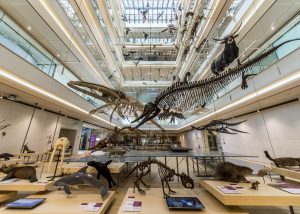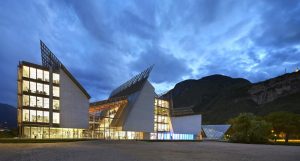
The MUSE is the Science Museum of Trento. It is a place worth visiting, a space rich in opportunities for growth and new perspectives for science lovers, but also for curious people of all ages.
Obviously, it is not a natural element, but an artificial construction that gently fits into the surrounding landscape. It is an attraction that brings in a steady stream of visitors to a city that is already interesting with its historical monuments and the many events related to its traditions.
The Museum inaugurated in 2013, is part of the wider project for the conversion of the former Michelin area, located on the edge of the old town center, next to the Adige River, in the western part of the city. The district, nowadays called Le Albere, has been designed to accommodate various functions, from residential to commercial, with the addition of a hotel, a convention center, and a public park.
First of all, the museum has been projected to blend harmoniously into the landscape in a distinctive yet harmonious way: its lines and surprising shapes recall those of the mountains, from the Bondone to the Marzola, with the high peaks and the steep slopes. The interior is also unusual: it has a stratified structure which corresponds to the metaphor of the alpine environment.

There are five floors above ground and two underground (one of which is the parking lot) in addition to a lateral space, the tropical greenhouse. Each floor circumscribes a large central cavity where there is an impressive installation, made up of specimens of taxidermist animals that almost twirl, suspended in the air at different levels. This installation almost outlines a descending temporal pattern that reflects the distribution of Alpine fauna.
The itinerary unfolds from the top to the bottom floors, and it includes interactive exhibits, educational workshops, and recreational-creative spaces for younger visitors that allow them to learn by playing. Starting from the fifth floor, which is not really part of the exhibition route, you will find the Vette Alte (“Tall Peaks”), which focuses on natural phenomena. In this section, you will discover glaciers and the effect of climate on flora and fauna. There is also a section dedicated to the explorers who have scaled these mountains.

The third floor is dedicated to Alpine Nature, to its inhabitants, and to their adaptation to the environmental and seasonal changes, with an area for children dedicated to the discovery of the forest environment and ecosystem. Then you will find the level dedicated to Geology and subsoil resources, their daily application, and environmental risk.
The first floor offers visitors insight into the history of primitive mankind, with particular attention to the presence of human traces in the Alpine territory, in addition to an explanatory area “Behind the scenes of the research”.
Finally, the last floor above ground is occupied by Interactive Science and the Maxi Ooh! for children. On the lower floor, you will find an area dedicated to the Traces of Life, where you can see fossils, graphs, and reconstructions of some of the most ancient forms of life that inhabited our planet and some modern mammals.
The hallway leading to the entrance of the greenhouse is very fascinating. Here a video illustrates the Little big secret of life, the evolution of biodiversity that unites all living creatures: DNA.
The final section of the museum is the greenhouse that reconstructs the environment of the Udzungwa Mountains in Tanzania, where the MUSE has established an ecological monitoring center.

Focusing again on the building itself, the attention that has been paid to its energy efficiency and overall environmental sustainability is incredible. The construction is, indeed, characterized by automated and mechanized systems that exploit geothermal and solar energy. In addition, rainwater collection tanks and radiant floor and skylight panels, as well as the outdoor lawn, not only provide a scientific atmosphere to the environment but also ensure water savings and maintain an optimal level of heating, ventilation, and lighting. All materials were locally sourced.
In addition to the permanent exhibitions, the museum also organizes temporary ones which can be found on the official website along with ticket info- reservations are mandatory.
For your overnight stay, we recommend…
55km away

Copyright photos: www.wikipedia.org; www.viamichelin.com; Sara F. Zanini (3 & 4)

